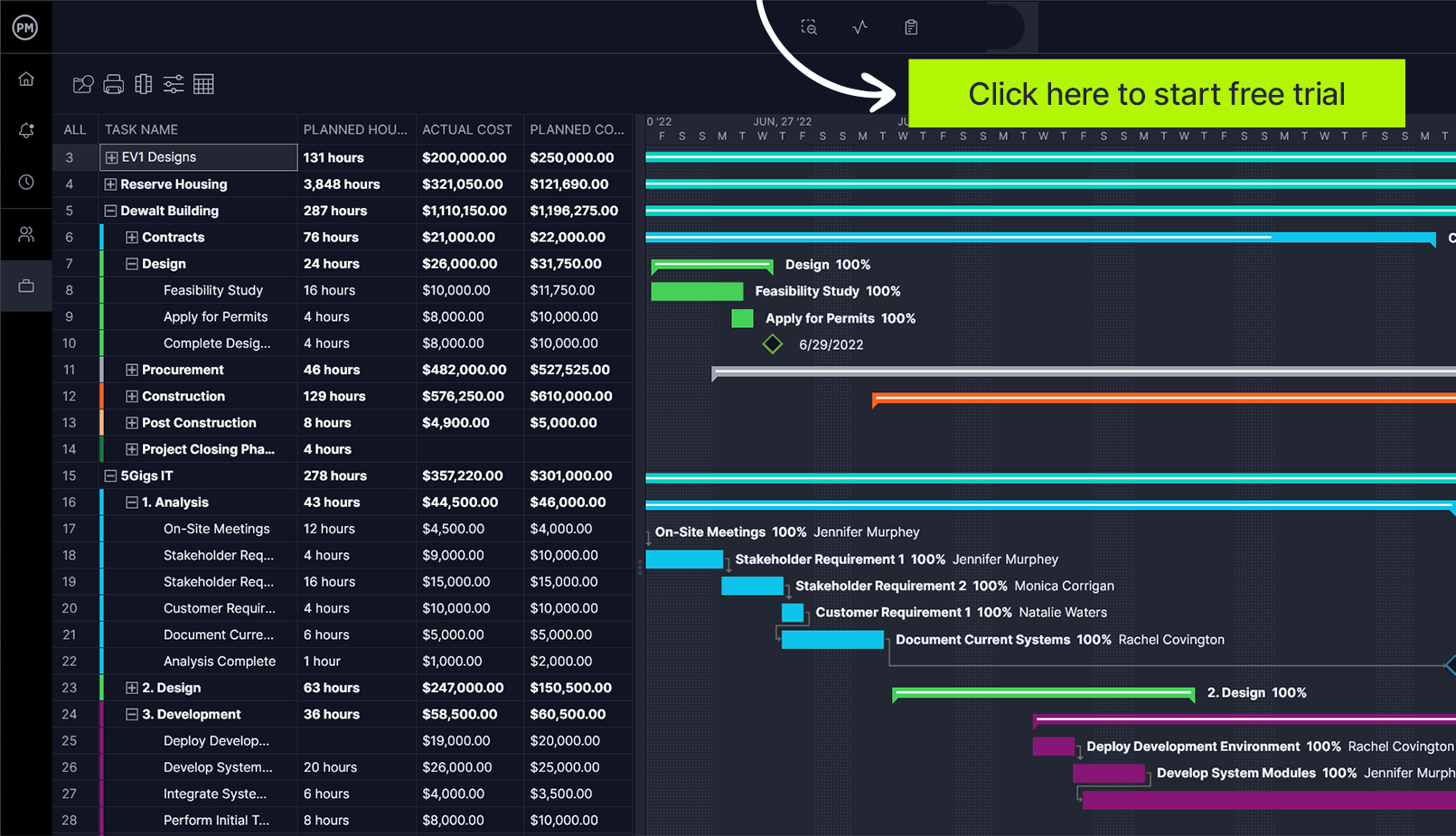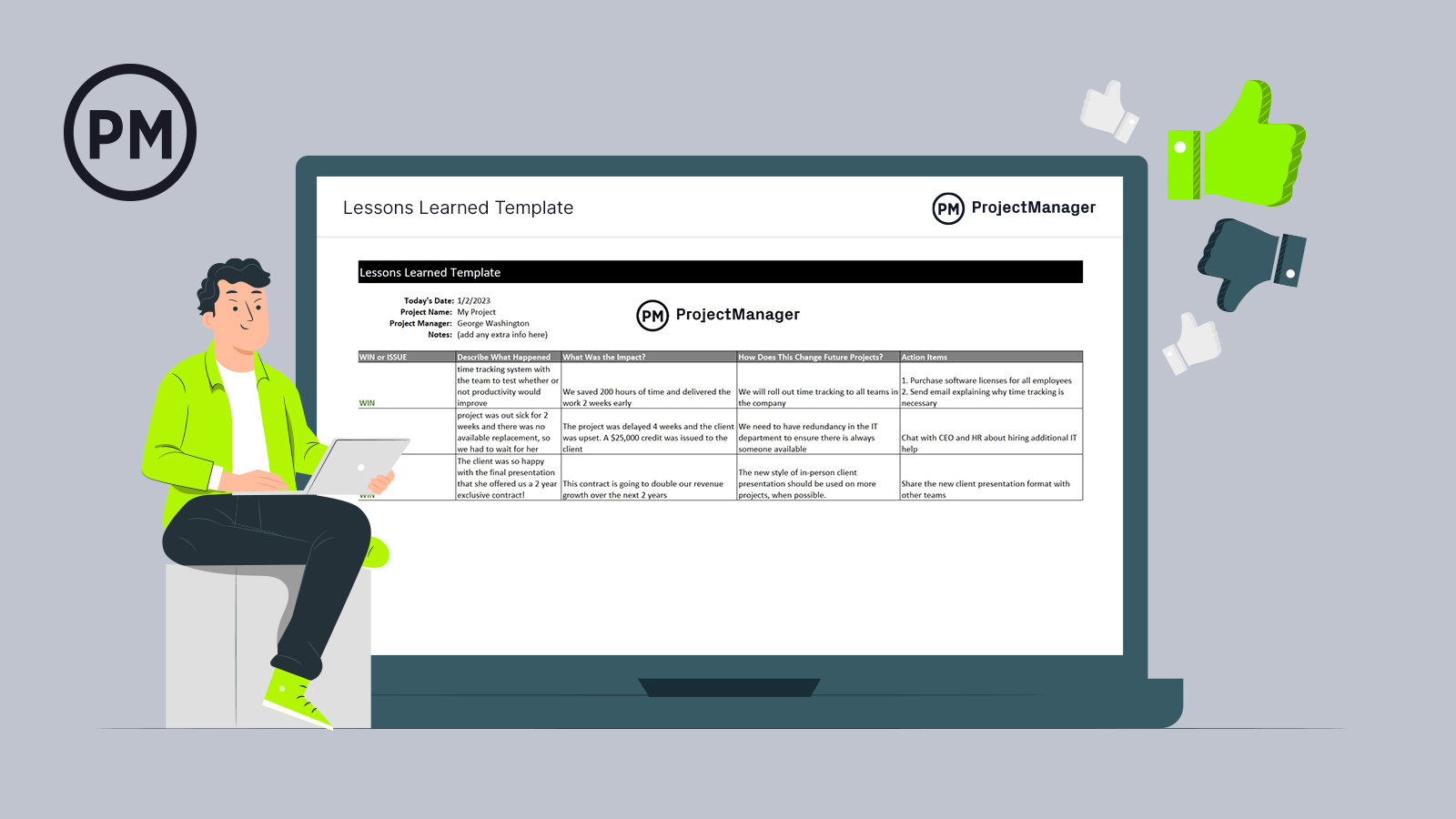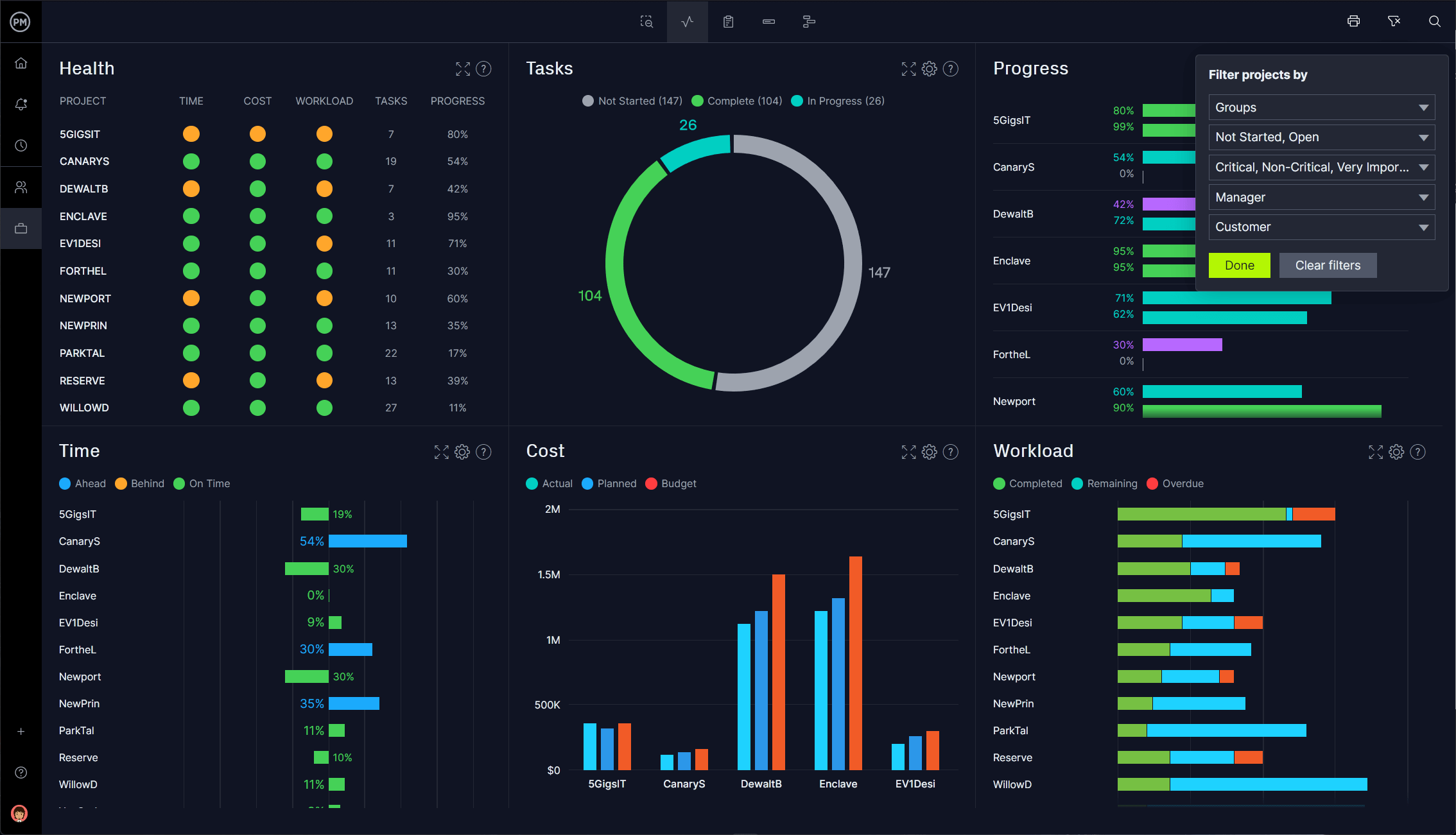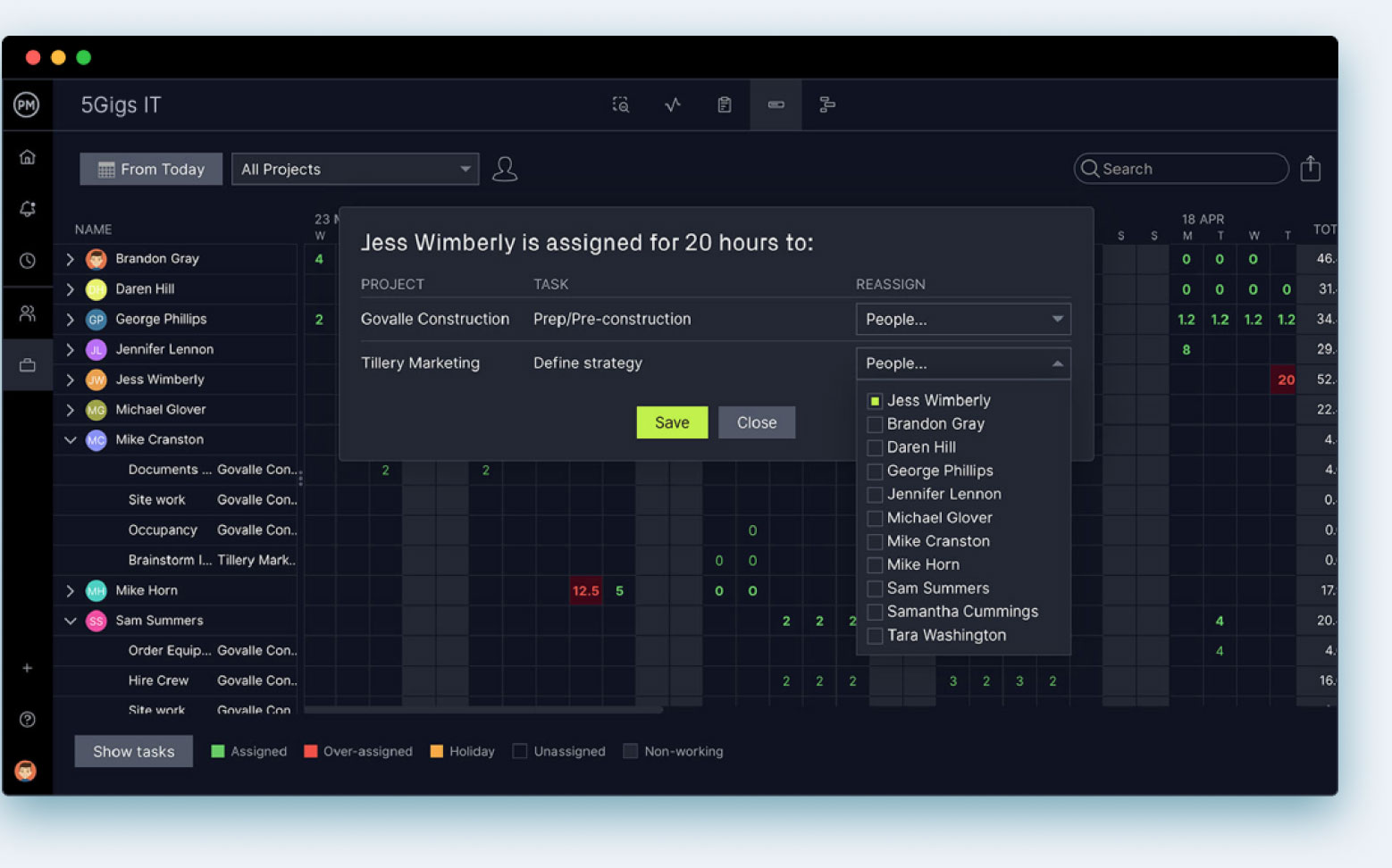Projects have a beginning, middle and end. That’s called the project life cycle. When you’re a project management office (PMO) or program or portfolio manager, you’re going to have to deal with multiple projects in various stages of the project pipeline.
What is a project pipeline? We’ll get to that in a moment as well as define project pipeline management. Then we’ll identify the stages of project pipeline management, what to track in your project pipeline and the tools that can help.
What Is a Project Pipeline?
The project pipeline can be thought of as a roadmap on which all your projects are represented. It shows each project as it moves from one stage to the next in the project management process, from initiation to closure.
Just like a roadmap, a project pipeline is a visual tool that illustrates the projects in your portfolio. It provides an overview of all those projects and thus allows the PMO, program or portfolio manager to make more informed decisions in terms of managing the various projects.
Project management software is a valuable tool for managing your project pipeline. ProjectManager is award-winning project and portfolio management software that has roadmaps to help you manage your project pipeline. Our roadmaps show all your projects on a Gantt chart and visual timeline, which helps you prioritize tasks, allocate resources more effectively and meet your project deadlines. Get started with ProjectManager today for free.

What Is Project Pipeline Management?
Project pipeline management is part of the larger project portfolio management process and involves selecting the right projects and ensuring that the right amount of project proposals are generated, evaluated and executed at the different stages of each project.
This prevents delays, creates efficiencies and ensures that nothing vital is lost in the flow of the many projects being managed. Project pipeline management accomplishes this by standardizing processes, overseeing the project as it progresses, allocating resources effectively, using risk management techniques to identify and mitigate issues and clear communication between stakeholders through regular updates.
Project pipeline management identifies and resolves bottlenecks, applies project management tools and prioritizes projects to increase efficiency. Therefore, all projects must be regularly reviewed and updated, teams stay in communication to foster better collaboration and real-time data is collected so there can be more insightful decision-making.
Project Pipeline Management Stages
To accomplish the goals of project pipeline management, the process goes through five stages. By following these project pipeline management stages a PMO, program or portfolio manager can better deal with the complexities of juggling multiple tasks.
1. Ideation
This is the brainstorming phase of the process. You’ll be coming up with project proposals that will deliver high-quality projects. Everyone on the project team should be involved and project management software can help facilitate this and keep a record of critical data as well as strike those ideas that aren’t feasible.
2. Work Intake and Project Proposal Review
Next, you take the viable ideas and pass them by your clients or stakeholders so they can review them and give you feedback. Here you’ll talk about the scope of the projects being proposed, how much they’ll cost and their return on investment. As the project team prepares to start on these projects, you’ll also be consulting investors, business partners, industry experts and more.
3. Planning
Once a project has been approved by your client, it’s time to plan out the project. At this point, you’re taking the larger project and dividing it into manageable phases and even smaller tasks and subtasks. You’ll also assemble a team, assign each their roles and responsibilities in the project, set deadlines for each task and schedule regular meetings to track progress and address issues. The final plan will be shared with the project team to ensure everyone is on the same page.
4. Work in Progress
As the project moves into the execution, monitoring and controlling phase, you’ll need to keep track of the progress and performance of your team to make sure that the project is on schedule and staying within the budget. This involves status updates, regular team meetings, monitoring key performance indicators (KPIs), identifying and rectifying issues and having stakeholder presentations to keep them up to date. You’ll be doing this for multiple projects and, therefore, will need to manage resources across those projects, prioritizing some and ensuring all are aligned with larger strategic goals.
5. Completed Projects
When the project is done and delivered to the client, your work isn’t finished. You can celebrate with the team, they deserve it! But there’s still paperwork to close out, releasing the team and doing a post implementation review. The latter is when you meet with the project team and go through what worked and what didn’t. These “lessons learned” will inform how you manage future projects so you don’t make the same mistakes.

Get your free
Lessons Learned Template
Use this free Lessons Learned Template for Excel to manage your projects better.
What Should You Track With a Project Pipeline?
To do all of the above, you need project management tools. They’ll help you track your project and capture any anomalies, including delays or cost overruns, so you can quickly address and resolve them. That’s why project management software is so important, as most will have many if not all of the features to do the following.
Project Progress
Being able to track the progress of your project will help you determine if you’re meeting the milestones on your schedule. Every task has a duration and if one task goes over its allotted time you might not be able to deliver the project as promised.
Estimated vs. Actual Costs
Every task has an associated cost and those planned costs must be monitored to ensure that they’re not exceeding what was earmarked for the task. An effective way to do that is to capture the planned cost and compare it to your actual cost. If you see the actual cost is more than what had been planned to be spent at that time, you’ll need to change the scope, schedule or request more funding.
Project Budget
The project budget is the total amount of the project. You’ll have made an accurate estimate of the project budget and now you have to keep to it. Therefore, just as you do with task tracking, you’ll need to track your planned budget against your actual budget to avoid overspending.
Project Timeline
The project timeline is a map of all your tasks from the start of the project to its completion. This is your schedule and you must stick to it. Therefore, you’ll be monitoring your progress by comparing your planned progress against your actual progress to ensure that it aligns with your project timeline.
Project Resources
Project resources are anything you use to get the project done. That includes your team, their equipment, any raw materials, etc. You need to monitor these resources and allocate them wisely. If you’re managing more than one project, all projects will be vying for the same, limited resources, therefore, you must monitor and allocate them carefully.
Project Scope
To monitor project scope, which defines goals, deadlines and deliverables in the project, you need to first define what is in scope for the project and what is out of scope. There are project management tools that can help, such as dashboards and reports, which we’ll get to in the next section. But, again, you need to compare the planned scope against the actual scope to help keep your project on track.
How to Manage Your Project Pipeline With Project Management Tools
To track the progress and performance of your projects, you’ll need project management tools. They provide a window into the project and give PMOs, program and portfolio managers the means to not only monitor but manage projects. The following is a brief overview of some of the most important of these tools.
- Gantt charts: Gantt charts are spreadsheets on the left and visual timelines on the right, which show the entire project. They organize tasks, link dependencies and more when scheduling a project. They can also assign resources and costs to each task for a robust project plan.
- Project dashboards: Project dashboards provide a high-level overview of the project, tracking various KPIs and displaying them on graphs and charts to provide a snapshot of the project in time.
- Project calendars: Project calendars show the project’s tasks on a calendar grip for a monthly overview of the project.
- Kanban boards: Kanban boards are a visual workflow tool that shows tasks on cards that move through the columns of the board, representing the production stages.
- Project status reports: The project status report is a snapshot of the project over a specific period, showing progress, costs and more for that period.
- Timesheets and workload charts: Timesheets are used for payroll, but can also track labor costs, while workload charts show team allocation and can help keep your team’s workload balanced.
Related Project Management Templates
If you’re not ready to upgrade to project management software, some templates can help you manage your project pipeline. ProjectManager has dozens of free project management templates for Excel and Word that address every phase of the project. Here are some that can be used in project pipeline management.
Project Dashboard Template
Our free project dashboard template for Excel gives you a high-level view of your project. Once you input the project data, our free template creates graphs and charts that show you tasks, workload, costs and more.
Project Budget Template
If you want to have an accurate budget forecast you’ll want to download our free project budget template for Excel. It lists all your tasks and their associated costs, including labor, materials, travel, equipment and more.
Resource Plan Template
Use our free resource plan template for Excel to list your tasks, team and their departments. You can also add their rates and total cost and then assign them on a weekly or monthly calendar grid.
How ProjectManager Helps With Project Pipeline Management
Our free templates can help you manage your project pipeline, but only to a degree. Because they’re static documents, you’ll have to manually update them, which is not efficient. Project management software streamlines those processes and more to help you work more effectively. ProjectManager is award-winning project and portfolio management software that has all the features you need to plan, manage and track your projects in real time. Our multiple project views give you and your team the choice between Gantt charts, kanban boards, task lists, sheet and calendar views, which are all updated together in real time.
Use Resource Management Features to Track Labor
Tracking resources in project pipeline management is important as you have to know which resources to allocate to which projects. Our timesheet feature is secure to safeguard your payroll process but also opens a window into how many of the tasks each team member has completed. They also track labor costs to help you stay on budget. To make sure teams are working at capacity, use our color-coded workload chart. It shows how much each team member is allocated and allows you to reallocate their tasks from the chart to balance the team’s workload and keep them productive.

Stay Updated With Real-Time Dashboards and Reports
To keep track of your KPIs, including planned vs. actual progress and cost, just toggle over to our real-time dashboard or portfolio dashboard. It captures live data and displays it on easy-to-read graphs and charts. You can quickly monitor costs, time, workload and more. Unlike lightweight tools, there’s no complicated and time-consuming setup with our dashboard. It’s ready when you are. If you need more details, use our customized reports. You can get status or portfolio reports and reports on workload, timesheets, variance and more. All reports can be shared to keep stakeholders informed.

To avoid potential problems, use our risk management features. It helps you identify risk, including its impact and likelihood of occurring, plus a plan of action if it does show up in the project. Then you can track it to make sure you’ve mitigated the issue.
ProjectManager is online project and portfolio management software that connects teams no matter where they are, in the office, out in the field or anywhere else. They can share files, comment at the task level and stay updated with email and in-app notifications. Join teams at Avis, Nestle and Siemens who are using our software to successfully manage their projects. Get started with ProjectManager today for free.


